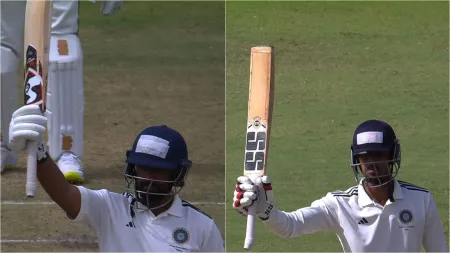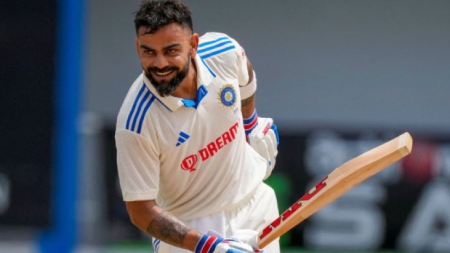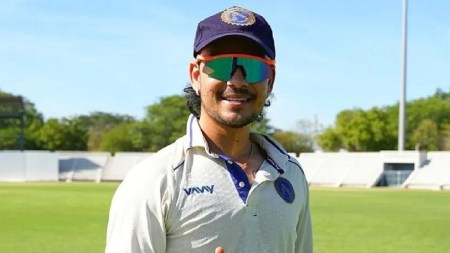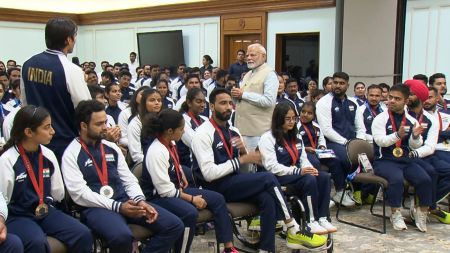Ishan Kishan slams hundred in Duleep Trophy to begin his comeback from notoriety
Ten months after his last appearance for the country, Ishan Kishan made his first comeback step in Anantapur. Dispelling a dark spell in his career, when he was out of the team not so much for the lack of runs as for his alleged indiscipline, he cracked a stroke-filled hundred for India C against India B in Anantapur, to emphasise that he has the control and character to reclaim the national stripes again.
The 126-ball 111 is the sort of counterattacking treatise that leaves an impression in the selectors memory. It’s easy to dismiss a score of 111 in a total of 357 for 5 as a happenstance. The standard assumptions roll forth—flatbed, flaccid attack and no stakes.

The reality was different. India C had lost two wickets in three balls, captain Ruturaj Gaikwad was in the pavilion retired hurt and India B has a sufficiently well-worn attack that features Navdeep Saini, Mukesh Kumar, both Test have-beens, the rising seam-bowling all-rounder Nitish Kumar Reddy and the resourceful spin trio of Washington Sundar, Sai Kishore and Rahul Chahar. This was a slippery juncture, made to look rosier by Kishan’s verve.
Until the first day of the second round of Duleep Trophy, his stars seemed to rebel. His return ambitions were stalled when he suffered a groin injury in the Buchi Babu Trophy; worse he missed the first round of the Duleep and at one stage feared that he wouldn’t get to face a single ball in the tournament. The four-day tournament was only the start of the long domestic season, yet he might have known the enormity of the campaign, and its wider ramifications.
He was making a comeback; not an ordinary comeback where he could push open the iron door of the selectors with the weight of the runs but one where he needed to reinforce that he has the order and discipline to earn the lost shirt, he has the head and heart to wear the responsibilities that come with representing the country. Talent was seldom the question with him, but his commitment arguably was. He had weathered the storm—which included him being dropped from the central contract list for skipping last season’s Ranji Trophy fixtures—he had told this newspaper in June. “I am in an excellent frame of mind. It’s a written rule that to make your comeback after your break you have to play in domestic cricket to prove your fitness. I just want to keep my head down and continue working on my game,” he said.
Understandably, to miss the start of the season would have been heartbreaking. Not least when a bunch of fresh and familiar faces have shoved him down the hierarchy. Rishabh Pant has returned, and would presumably be the first-choice wicket-keeper across formats; Dhruv Jurel displayed his calmness and bravado in equal measure in the England Tests. Railways’ Upendra Singh and Jharkhand youngster Kumar Kushagra are knocking on the doors. In the ODIs, the utility of KL Rahul has edged him and Sanju Samson is still in the scheme. In the shortest formats, he has to bypass a queue of Jurel, Samson and Jitesh Sharma.
Yet, he brims with virtues that could tempt selectors into breaking the line—of all, the gift of explosiveness burns the brightest in him. Propelled by his blinding bat-speed, incredible base strength and rubbery wrists, he could start hitting the ball straightaway, in tune with India’s white-ball zeitgeist. Besides, he is the sole left-hander in the group, the closest clone to Pant, the most flexible one (can juggle multiple roles) and the most consistent one. But for his transgression, he had nailed himself as the second-choice keeper. Samson is erratic; Jurel is still in early days, and the rest is still largely untested at the international level.
This would perhaps hurt him more, that had secured the spot but contrived to squander it and now has to earn it back. He had accosted competently to the rigours of international cricket—an average of 42 in ODIs, where he had looked better than Pant, still not yet fully grasped the mechanics of it; 78 in his three Test outings and had cracked the T20I code in his last few games for the country (a pair of whirlwind 50s in his last series, against Australia).
With so much riding on him, he could ill-afford to miss the season starting tournament. He would as well be flirting with oblivion, factoring the intense depth of talent at India’s disposal. If he had missed the Duleep, or fired blanks, he would have inevitably missed a spot in the Irani Cup at the start of October. By the time the Ranji Trophy season winks by, in mid-October, the outlines of the Australia squad would have assumed thicker outlines. A new batch of contenders would have emerged, and disordered the hierarchy.
A spot in the squad for Australia is a long shot, but it’s not beyond him. For a 50-day tour, India would definitely pack two specialists wicketkeepers, and when picking the back-up (assuming Pant is fully fit and the first choice), the team management could weigh in a lot of factors, like form, experience, multi-utility, attitude, work ethics and the type of knocks he plays.
A few more hundreds of similar nature as this at Anantapur in the coming months, and the road back to international cricket would look shorter.
Disclaimer: The copyright of this article belongs to the original author. Reposting this article is solely for the purpose of information dissemination and does not constitute any investment advice. If there is any infringement, please contact us immediately. We will make corrections or deletions as necessary. Thank you.





